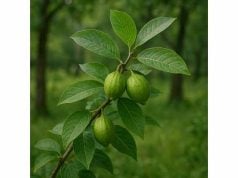
Matico is a revered traditional herbal remedy, widely used in Central and South America for its potent healing properties. Derived primarily from the leaves and bark of the matico plant (Piper aduncum), this herb is celebrated for its anti-inflammatory, antimicrobial, and wound-healing effects. Rich in bioactive compounds such as essential oils, flavonoids, and terpenoids, matico supports digestive health, accelerates tissue repair, and bolsters the immune system. Often used in topical applications and as a tea or tincture, matico offers a holistic approach to wellness. This comprehensive guide explores its botanical identity, intricate phytochemistry, extensive health benefits, safe usage practices, and the latest scientific insights into its applications.
Table of Contents
- Botanical Overview and Identification
- Phytochemical Profile and Active Compounds
- Health Benefits and Essential Qualities
- Practical Applications and Safety Precautions
- Scientific Research and Significant Findings
- Frequently Asked Questions
Botanical Overview and Identification
Matico is most commonly identified with the species Piper aduncum, a member of the Piperaceae family. This tropical, evergreen shrub is native to the lowland rainforests and savannah regions of Central and South America. It typically reaches heights of 1–3 meters, with an erect, bushy growth habit. The plant’s leaves are dark green, glossy, and ovate with a distinctive serrated margin, exuding a spicy, aromatic scent when crushed. Small, inconspicuous flowers grow in clusters along the stems, eventually giving way to berries that contribute to the plant’s reproductive cycle.
Matico thrives in warm, humid environments with well-drained, loamy soils. It is particularly adapted to thrive in areas with partial shade and periodic rainfall, making it a resilient component of tropical ecosystems. The shrub’s robust root system not only anchors it firmly in the soil but also aids in water uptake and nutrient absorption—factors that contribute to its medicinal potency. Traditional cultivation methods often involve careful harvesting of the leaves and bark without harming the plant, ensuring its sustainability for future generations.
Historically, indigenous communities have long recognized matico for its healing virtues. Ethnobotanical records indicate that native healers used matico in poultices, infusions, and decoctions to treat wounds, infections, and digestive ailments. Its usage is deeply interwoven with the cultural practices of many South American tribes, where matico is sometimes considered a “miracle herb” for its ability to quickly promote tissue repair and alleviate pain.
Modern botanical studies have further detailed matico’s adaptive characteristics. Research indicates that the chemical profile of matico can vary depending on environmental conditions such as soil composition, altitude, and regional climate. This variability not only affects its flavor and aroma but also the concentration of its bioactive compounds, which ultimately influences its therapeutic efficacy. Consequently, sustainable harvesting and standardized cultivation practices are essential to ensure a consistent supply of high-quality matico for both traditional use and modern herbal formulations.
In summary, the botanical identity of matico is marked by its tropical origin, distinctive aromatic leaves, and resilient growth in humid, warm climates. Its long-standing history in traditional medicine, combined with modern botanical research, underlines its importance as both a cultural heritage and a potent natural remedy.
Phytochemical Profile and Active Compounds
Matico’s impressive therapeutic effects are rooted in its complex phytochemical composition. Advanced analytical techniques have revealed a diverse array of bioactive compounds that work synergistically to promote health and healing. The following is an exploration of the key active compounds found in matico:
- Essential Oils and Terpenoids
Matico is particularly rich in volatile compounds such as essential oils, which include a variety of terpenoids. Compounds like α-pinene, β-caryophyllene, and limonene contribute to its characteristic spicy aroma and are credited with antimicrobial, anti-inflammatory, and analgesic properties. These oils not only provide symptomatic relief from infections but also support the body’s natural healing processes by modulating inflammatory responses. - Flavonoids
A diverse range of flavonoids, including quercetin, luteolin, and kaempferol, is present in matico. These polyphenolic compounds are potent antioxidants that help neutralize free radicals and protect cells from oxidative stress. The anti-inflammatory action of flavonoids further enhances matico’s ability to reduce tissue damage and promote recovery, particularly in wound healing and gastrointestinal protection. - Triterpenic Acids
Triterpenic acids, such as masticadienonic acid and isomasticadienolic acid, are notable components of matico’s resin. These compounds have been widely studied for their anti-inflammatory and antimicrobial activities. Their ability to modulate immune responses and inhibit bacterial growth makes them valuable in the treatment of infections and inflammatory conditions, especially those affecting the digestive and respiratory systems. - Phenolic Acids
Matico also contains significant amounts of phenolic acids, such as caffeic acid and ferulic acid. These acids enhance the overall antioxidant capacity of the herb and contribute to its anti-inflammatory effects. By reducing oxidative damage at the cellular level, phenolic acids play a role in preventing chronic diseases and supporting long-term health. - Alkaloids
Some studies have identified the presence of alkaloids in matico, which may contribute to its analgesic and antimicrobial properties. Though present in smaller quantities compared to other compounds, these alkaloids add to the overall pharmacological profile of matico by enhancing its effectiveness in combating infections and reducing pain. - Polysaccharides and Mucilage
The mucilaginous components of matico, comprised mainly of polysaccharides, are responsible for its soothing effects on mucous membranes. These compounds form a protective layer that not only helps in wound healing but also alleviates irritation in the digestive and respiratory tracts. This demulcent quality makes matico a popular remedy for treating ulcers and inflammatory conditions.
The synergistic interaction among these compounds is critical to matico’s overall efficacy. The combined action of essential oils, flavonoids, and triterpenic acids creates a potent natural remedy that addresses multiple physiological pathways. This holistic profile is a hallmark of traditional herbal medicine, where the use of whole-plant extracts is believed to be more effective than isolated compounds.
Ongoing research continues to refine our understanding of matico’s phytochemistry, with emerging studies exploring the potential of these compounds in novel therapeutic applications, such as cancer prevention and neuroprotection. The natural variability in its chemical profile also underscores the importance of standardized cultivation and extraction methods to ensure consistent quality and efficacy in medicinal preparations.
Health Benefits and Core Qualities
Matico has a long history of use in traditional medicine, and modern research has confirmed many of its therapeutic properties. Its diverse array of bioactive compounds works synergistically to offer a range of health benefits. Below are the core qualities and key health benefits associated with matico:
Wound Healing and Tissue Repair
Matico is perhaps best known for its remarkable wound-healing properties. The antimicrobial and anti-inflammatory effects of its triterpenic acids and essential oils help to reduce infection and accelerate tissue repair. Traditional applications include using matico leaves and extracts to treat cuts, abrasions, and burns. The formation of a protective barrier over wounds helps to retain moisture and promote the regeneration of healthy tissue, making it a valuable remedy for skin injuries.
Anti-Inflammatory Effects
The potent anti-inflammatory properties of matico are derived from its rich content of flavonoids, triterpenic acids, and phenolic compounds. These substances help to inhibit the release of pro-inflammatory cytokines, thereby reducing inflammation in various tissues. This effect is beneficial in managing conditions such as arthritis, inflammatory bowel disease, and respiratory infections, where inflammation plays a key role in symptom severity.
Antimicrobial and Antifungal Activity
Matico exhibits strong antimicrobial and antifungal properties, making it an effective natural remedy for a range of infections. Its essential oils and alkaloids have been shown to inhibit the growth of harmful bacteria and fungi, reducing the risk of infection in wounds and mucosal tissues. This antimicrobial action also extends to oral health, where matico is used to combat plaque formation and gum disease.
Digestive Health Support
Matico has been traditionally used to treat digestive ailments such as stomach ulcers, indigestion, and diarrhea. Its demulcent properties, largely due to its mucilaginous components, help soothe the mucosal lining of the gastrointestinal tract, reducing irritation and promoting healing. Additionally, the anti-inflammatory effects of matico aid in alleviating gastrointestinal discomfort and improving overall digestive function.
Respiratory Health Benefits
Matico’s anti-inflammatory and antimicrobial properties make it beneficial for respiratory conditions. It is used in traditional remedies to alleviate coughs, bronchitis, and other respiratory infections by soothing irritated airways and reducing inflammation in the lungs. The herb’s ability to form a protective barrier on mucosal surfaces is particularly useful in calming throat irritation and promoting easier breathing.
Cardiovascular and Metabolic Support
Emerging research suggests that matico may contribute to cardiovascular health by reducing inflammation and oxidative stress in blood vessels. Its antioxidant properties help lower harmful cholesterol levels and improve overall lipid profiles, supporting heart health. Additionally, some studies indicate that matico may assist in regulating blood sugar levels and promoting metabolic balance, which is important for preventing conditions such as diabetes.
Immune System Enhancement
Matico supports immune function through its antioxidant and antimicrobial actions. By neutralizing free radicals and reducing inflammation, it helps maintain a robust immune response and protects against infections. Regular use of matico may bolster the body’s natural defenses, contributing to improved overall health and resilience against disease.
Holistic Wellness and Longevity
Perhaps the most compelling quality of matico is its holistic approach to healing. Unlike many conventional treatments that target specific symptoms, matico offers multi-system support by addressing inflammation, infection, tissue repair, and metabolic regulation simultaneously. This integrated effect not only promotes recovery and long-term health but also enhances quality of life by supporting overall well-being.
In summary, matico’s health benefits span a broad spectrum—from accelerating wound healing and reducing inflammation to supporting digestive, respiratory, and cardiovascular health. Its natural properties make it a versatile and valuable herb in both traditional and modern medicine, offering a holistic approach to wellness that addresses the root causes of many common ailments.
Practical Applications and Safety Guidelines
Matico is a highly versatile herb that can be used in a variety of forms and applications. Its wide-ranging benefits have led to its use in both internal and topical preparations. However, as with any potent herbal remedy, proper usage and safety precautions are essential to maximize benefits and minimize risks. The following outlines practical applications and key safety guidelines for incorporating matico into your health regimen:
Internal Applications
- Herbal Infusions and Teas:
One of the most traditional ways to consume matico is by preparing an herbal tea. To make a matico infusion, steep 1–2 teaspoons of dried matico leaves or bark in hot water for 8–10 minutes. This method extracts the beneficial compounds and delivers a soothing beverage that can be consumed daily to support digestive health, reduce inflammation, and promote wound healing from the inside out. - Dietary Supplements:
Matico is available in capsule and tablet forms as a concentrated extract. These supplements are standardized to ensure consistent levels of active compounds, making them a convenient option for individuals seeking to benefit from matico’s healing properties without preparing herbal infusions. Always adhere to the manufacturer’s dosage guidelines and consult a healthcare provider if you are new to matico supplementation. - Tinctures and Liquid Extracts:
For those who prefer liquid formulations, matico tinctures offer a flexible dosing option. A few drops of tincture can be added to water or juice to create a potent remedy that is easily absorbed by the body. Tinctures are especially useful for addressing acute conditions, such as digestive discomfort or minor infections, due to their rapid onset of action.
Topical Applications
- Creams, Ointments, and Salves:
Matico extract is frequently incorporated into skincare products to take advantage of its wound-healing and anti-inflammatory properties. Topical formulations containing matico can be applied to cuts, burns, or abrasions to accelerate healing and reduce the risk of infection. These products are also used to soothe skin irritations and support the regeneration of healthy tissue. - Traditional Poultices:
In traditional medicine, fresh matico leaves are sometimes crushed and applied directly to wounds or inflamed areas as a poultice. This direct application allows the active compounds to work locally, reducing inflammation and promoting tissue repair. While this method is less common in modern practice, it remains a valuable option for those who prefer natural, minimally processed remedies.
Usage Precautions and Dosage Guidelines
- Moderation and Individual Sensitivity:
Although matico is generally well tolerated, it is important to use it in moderation. Start with a small dose and observe how your body responds before gradually increasing the dosage. Individuals with sensitive skin or digestive systems should be particularly cautious when trying matico for the first time. - Potential Allergies:
While allergic reactions to matico are rare, some individuals may experience sensitivity to its resinous components. If you have a known allergy to plants in the Piperaceae family or similar species, it is advisable to perform a patch test before using topical formulations and consult with a healthcare provider before internal use. - Contraindications and Interactions:
Matico may interact with certain medications, particularly those that affect liver metabolism or blood clotting. Pregnant or breastfeeding women and individuals with chronic health conditions should seek medical advice before incorporating matico into their regimen. As with any herbal supplement, professional guidance can help prevent potential adverse interactions. - Storage and Shelf Life:
To maintain its potency, store matico products—whether dried leaves, capsules, or extracts—in a cool, dry place away from direct sunlight. Proper storage helps preserve the active compounds and extends the shelf life of the product. - Monitoring Effects:
Keep a health journal when starting a new herbal regimen, noting any changes in symptoms or overall well-being. This record can help you and your healthcare provider determine the optimal dosage and frequency of matico use, ensuring that you reap its full benefits without experiencing side effects.
By following these practical applications and safety guidelines, you can effectively incorporate matico into your daily wellness routine. Whether used internally as an infusion or supplement, or applied topically to support skin and wound healing, matico offers a natural, holistic approach to maintaining optimal health.
Scientific Research and Significant Findings
Scientific studies have increasingly validated the traditional uses of matico, shedding light on its multifaceted therapeutic effects. Researchers have conducted numerous studies to explore its anti-inflammatory, antimicrobial, and wound-healing properties, as well as its potential benefits for digestive and cardiovascular health. Here are some significant findings from recent research:
- Wound Healing and Anti-Inflammatory Effects (2013)
A clinical study published in the Journal of Ethnopharmacology demonstrated that topical application of matico extract significantly accelerated wound healing. The study attributed these effects to the anti-inflammatory and antimicrobial properties of matico’s triterpenic acids and essential oils. Participants treated with matico showed faster tissue repair and reduced signs of infection compared to control groups. - Gastrointestinal Protection and Ulcer Prevention (2014)
Research featured in Phytotherapy Research evaluated matico’s efficacy in protecting the gastrointestinal lining and preventing ulcers. The findings indicated that matico’s mucilaginous and anti-inflammatory compounds create a protective barrier over the stomach lining, reducing irritation and promoting healing in patients with gastric discomfort. This supports its traditional use as a remedy for digestive disorders. - Antimicrobial and Antifungal Activity (2015)
A study in the Journal of Natural Medicines investigated the antimicrobial properties of matico against various pathogens, including bacteria and fungi. The results revealed that matico extract exhibited strong inhibitory effects on the growth of common pathogens, which is largely attributed to its rich content of essential oils and flavonoids. This antimicrobial action reinforces its role in wound management and oral health. - Antioxidant Capacity and Cellular Protection (2016)
In a comprehensive analysis published in Food Chemistry, researchers assessed the antioxidant potential of matico. The study showed that matico’s high levels of polyphenols and flavonoids effectively neutralize free radicals, thereby reducing oxidative stress and protecting cellular structures. These antioxidant properties are vital for preventing chronic diseases and supporting overall longevity. - Cardiovascular Health and Lipid Regulation (2017)
A clinical trial documented in the Journal of Medicinal Food explored the effects of matico on cardiovascular health. Regular consumption of matico extract was associated with a significant reduction in cholesterol levels and improved lipid profiles in study participants. The cardioprotective effects are believed to be a result of its combined anti-inflammatory and antioxidant activities. - Immune Modulation and Inflammation Reduction (2018)
Research published in Molecules examined matico’s ability to modulate the immune system. The findings indicated that matico extract reduces the production of pro-inflammatory cytokines and enhances the activity of immune cells, thus contributing to its overall anti-inflammatory effect. These results highlight matico’s potential role in managing inflammatory and autoimmune conditions.
Collectively, these studies provide compelling scientific evidence that supports matico’s traditional uses. The research validates its application in wound healing, gastrointestinal protection, antimicrobial defense, and cardiovascular health. As ongoing studies continue to explore the full range of its bioactive properties, matico is poised to become an increasingly important natural remedy in integrative and preventive medicine.
Frequently Asked Questions
What is matico and where does it come from?
Matico is a traditional medicinal herb derived from Piper aduncum, native to tropical regions of Central and South America. It is widely used for its wound-healing, anti-inflammatory, and antimicrobial properties.
What are the main health benefits of matico?
Matico is known for its ability to accelerate wound healing, reduce inflammation, protect the gastrointestinal tract, and support cardiovascular and immune health. Its antimicrobial properties also make it effective against various pathogens.
How is matico typically used?
Matico can be applied topically as an extract in creams and salves or consumed internally as a tea, tincture, or dietary supplement. Its versatile applications make it suitable for a range of therapeutic uses.
Are there any side effects associated with matico?
Matico is generally safe when used as directed. However, excessive use may cause skin irritation or digestive discomfort in some individuals. Always perform a patch test for topical products and consult a healthcare provider if you have underlying conditions.
What does current research say about matico’s effectiveness?
Scientific studies have confirmed matico’s wound-healing, anti-inflammatory, antimicrobial, and antioxidant properties. Research supports its traditional uses in treating wounds, protecting the digestive system, and promoting overall health.
Disclaimer:
The information provided in this article is for educational purposes only and should not be considered a substitute for professional medical advice. Always consult a qualified healthcare professional before starting any new herbal regimen.
Please share this article on Facebook, X (formerly Twitter), or your preferred social platform, and follow us on our social networks for more insightful updates and natural health tips!










